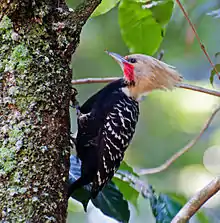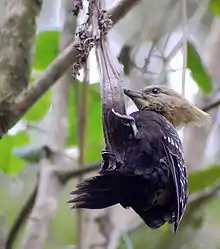Blond-crested woodpecker
The blond-crested woodpecker (Celeus flavescens) is a species of bird in the family Picidae, the woodpeckers, piculets and wrynecks. It is found in Brazil, southeastern Paraguay, and extreme northeastern Argentina. A small disjunct population occurs at the Amazon River mouth and upstream, including the southern part of Ilha de Marajo. The ochre-backed woodpecker is sometimes considered a subspecies. Its natural habitats are subtropical or tropical moist lowland forests, subtropical or tropical dry shrubland, and heavily degraded former forest.
| Blond-crested woodpecker | |
|---|---|
 | |
| Male in São Paulo, Brazil | |
 | |
| Female | |
| Scientific classification | |
| Kingdom: | Animalia |
| Phylum: | Chordata |
| Class: | Aves |
| Order: | Piciformes |
| Family: | Picidae |
| Genus: | Celeus |
| Species: | C. flavescens |
| Binomial name | |
| Celeus flavescens (Gmelin, 1788) | |
Description
The blond-crested woodpecker grows to a length of about 28 cm (11 in). The crown, crest, nape, face and throat are cream, yellowish or ochre, depending on subspecies. The male has bright red patches on the cheeks, but the female lacks these, instead having blackish cheeks or cream cheeks with a few dark streaks. The spiky crest makes the head seem large. The mantle, back and wings are blackish, dark brown or ochre, lightly barred with buff or yellow. The rump is yellowish and the tail is black. The underparts are plain black or dark brown, sometimes finely barred with buff. The eye is reddish, and the beak and legs are grey.[2]
Distribution and habitat
In eastern and southeastern South America, the blond-crested woodpecker ranges in eastern and central portions of the cerrado; it is also in most of the caatinga. A small range of the bird, (disjunct), occurs at the mouth of the Amazon River and upstream for 800 km in the Amazon basin; the range also covers the southern parts of Marajó Island. Its habitats include rainforest, gallery forest, plantations, palm groves, wooded savannah, orchards and gardens, at altitudes up to 1,200 m (4,000 ft).[2]
Ecology
The blond-crested woodpecker feeds on insects, mostly ants and termites on trees. It sometimes breaks into ant nests, creating cavities in which it nests. It also feeds on other invertebrates, fruit, seeds and sap, and is an important pollinator and disperser of seeds.[2]
References
- BirdLife International (2012). "Celeus flavescens". IUCN Red List of Threatened Species. 2012. Retrieved 26 November 2013.CS1 maint: ref=harv (link)
- Gorman, Gerard (2014). Woodpeckers of the World: A Photographic Guide. Firefly Books. p. 375–376. ISBN 177085309X.
External links
- Blond-crested woodpecker videos on the Internet Bird Collection
- Blond-crested woodpecker photo gallery VIREO Photo-High Res
- Blond-crested woodpecker: Photos, vocalizations from The Birds of the Interior of Ceará, Brazil
